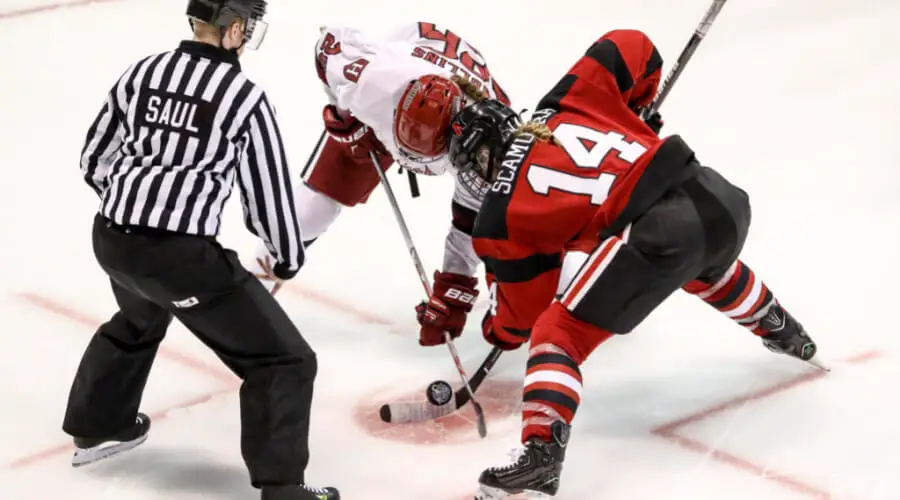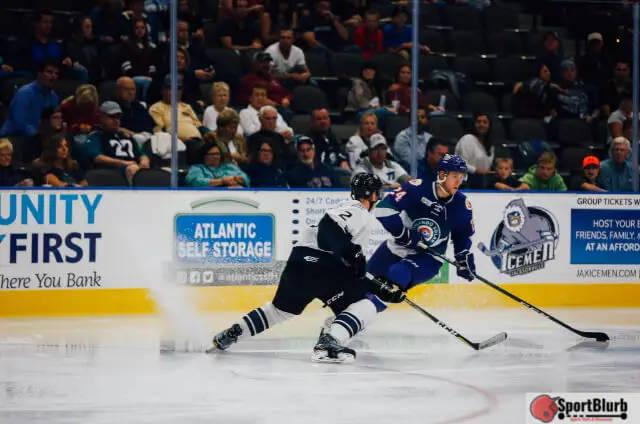Last Updated on October 12, 2023 by Alex PT
In ice hockey, teams score by shooting the puck into the opponent’s net. A goal counts as one point. If a game ends in a tie, it may go to overtime or a shootout, awarding extra points to the winner in the NHL standings.
Ice Hockey Scoring System
1. An even-strength goal is the type of goal scored in an ice hockey game where both teams have an equal number of players on the rink.
2. A power-play goal otherwise known as “PPG” is a type of goal scored when a team is in a power play. It happens when a team has a numerical advantage in players due to a penalty being performed by one or more of the opposition players.
3. A shorthanded goal otherwise known as “SHG” is a type of goal scored by a team on the penalty kill. It happens when a team has a numerical disadvantage due to a penalty being performed by one or more of its players.
4. An empty-net goal otherwise known as “ENG” is a type of goal scored when the goalkeeper isn’t at goal guarding the net. So, the goal is scored freely without anyone trying to stop it.
5. A penalty shot goal is another type of goal scored on a plain penalty shot. It happens when a single offensive player has a one-on-one confrontation with the goaltender as a result of a penalty.
6. An awarded goal is any type of goal awarded when a goaltender has been pulled out of the goal and then a foul happens to stop a triggered penalty shot.
7. An own goal happens when a player scores in his own net by putting the puck across his team’s goal line. In ice hockey, the goal credit will be given to the last opponent to touch the puck.
8. An overtime goal is a type of goal scored when the puck crosses the goal line during sudden-death overtime.
9. A go-ahead goal is the first goal to be scored after the game has been tied between the two teams.
10. An equalizer is a type of goal scored to tie a game. It is normally scored by a team that’s one goal down.
11. A game-winning goal otherwise known as “GWG” is the type of goal scored to put a team in a winning position.
How Does a Goal Occur in a Hockey Game?
A goal in a hockey game occurs when a player successfully propels the puck into the opponent’s net, following specific rules:
- Scoring Objective: The objective is to get the puck past the opposing team’s goaltender and into their net.
- Rules for Scoring:
- The entire puck must completely cross the goal line between the goalposts and under the crossbar.
- The puck can be struck with any part of the body except the hand, and it can deflect off other players (excluding the goaltender) before entering the net.
- Assists: In many cases, goals are the result of teamwork. A player who passes the puck to the goal scorer is credited with an “assist” if applicable.
- Power Plays: Goals may occur during a power play when one team has a numerical advantage due to a penalty to the opposing team. Scoring during a power play is particularly important.
- Goaltender’s Role: The opposing goaltender’s primary job is to prevent goals. They use their body, glove, and stick to block or catch the puck.
- Goal Celebration: After scoring, players often celebrate by raising their sticks and skating toward the bench. Scoring is a moment of triumph, and celebrations can be quite elaborate.
- Video Review: In some cases, goals are subject to video review to ensure the puck completely crossed the goal line. This is particularly important in critical situations.
- Scoring in Overtime: In sudden-death overtime, the first team to score wins the game. Overtime goals have an additional level of significance.
What Happens if the Puck Is on the Goal Line in the Net?
If the puck is on the goal line in the net in a hockey game, it typically results in a goal. Here’s what happens:
- Complete Cross: For a goal to be awarded, the entire puck must completely cross the goal line. This means even if a portion of the puck is touching or hovering above the goal line, it is considered a goal.
- Referee’s Decision: The on-ice referees are responsible for making the call. They have a direct view of the play and make a quick judgment.
- Video Review: In some cases, especially in critical situations or when there is doubt about the puck crossing the line, the game officials may use video review technology to confirm the goal.
- Goal Signal: When a goal is scored, the referee will make a distinct hand signal, often pointing at the net to indicate the goal is valid.
- Restart: After a goal is scored, the game restarts with a face-off at center ice. The team that was scored against typically concedes possession to the scoring team.
- Goal Celebration: Scoring a goal is a moment of celebration for the team that scored. Players often raise their sticks, and there may be elaborate celebrations.
What is a Goal Violation in Ice Hockey?
A goal violation in ice hockey refers to a situation where the scoring of a goal is disallowed or deemed invalid due to a breach of the game’s rules or regulations. Goal violations can occur for various reasons, and it’s crucial for officials to ensure fair play. Here are some common scenarios that constitute a goal violation in ice hockey:
- Offsides: A goal is disallowed if the attacking team enters the offensive zone (the opponent’s end of the ice) before the puck does. This is called an “offsides” violation.
- High Sticking: If a player uses their stick to contact the puck above the height of the crossbar and subsequently scores a goal, it’s considered a goal violation.
- Interference: If a player interferes with the opposing goaltender, preventing them from making a save, the goal may be disallowed due to “goaltender interference.”
- Hand Pass: Scoring a goal with a direct hand pass (using the hand to propel the puck to a teammate) is generally not allowed. If a goal results from a hand pass, it’s considered a violation.
- Kicking: A goal is disallowed if the puck is intentionally kicked into the net by a player. However, if it deflects off a player’s skate without an intentional kicking motion, it may still count as a goal.
- Goaltender Covering the Puck: If the opposing team scores while the goaltender has the puck covered, it’s often ruled as a violation. Play is usually stopped when the goaltender has control.
- Offensive Crease Violation: In some cases, players may not be allowed in the opposing team’s crease (the area in front of the net) before the puck. Scoring a goal from within this restricted area could result in a goal violation.
- Too Many Players on the Ice: If a team has too many players on the ice during a goal-scoring play, it can lead to a goal violation. The extra player’s presence is typically penalized.
- Video Review: In critical situations or when there is uncertainty, game officials may use video review to determine if a goal is valid or if it constitutes a violation.
Teams In Ice Hockey

Each team has six in-field players who are allowed to be on the ice at a time. But a full team consists of 20 players with two goaltenders. Besides, ice hockey allows for substitution at any point in the game.
Match Officials In Ice Hockey Games
The game of ice hockey is controlled by a referee who decides on any matter at any point in the game. The referee usually wears a red armband and he’s assisted by linemen, whose job is to monitor offside. The referee is also assisted by goal judges whose job is to see whether or not the puck has crossed the goal line.
Penalties In Ice Hockey
There are two major types of penalties in the game of ice hockey, and they include major and minor penalties. A major penalty is given when there’s an occurrence of more serious physical contact such as fighting. Offending players of a major penalty are normally sent off the rink permanently. However, minor penalties only result in an offending player being withdrawn from the rink for 2 minutes.
FAQs
Here are some frequently asked questions and answers to help you understand the ice hockey scoring system. Let’s go through them!
What Is It Called When Mg Score 4 Goals In Hockey?
In a game of hockey game, scoring four goals happen less frequently than a hat trick. However, if a player scores four goals in a single game, then it is normally referred to as a “Texas hat trick”. How this lingo originated isn’t really clear as it is less commonly used than a normal hat trick.
What Are The 3 Scores In Ice Hockey?
If you’re a devoted fan of ice hockey, you’ll notice there are 3 numbers close to an NHL team’s name or logo. These 3 numbers refer to the team’s “Wins-Regulation Losses-Overtime Losses” record in the league. The separation of regulation and overtime losses are due to their value in the standings. Overtime losses earn teams a point while regulation losses earn them 0 points.
How Is The Scoring Done In Ice Hockey?
In ice hockey, scoring is done by putting the puck across the goal line, under the crossbar of the goal between the posts. Before each period expires, the puck must have crossed the goal line irrespective of when the shot was taken. If the goal is moved at any point during the game, a goal can’t be scored. Any goal scored will be disallowed.
Closing Thoughts
A goal is scored in the game of ice hockey when the puck crosses the goal line below the goal crossbar and between the two goalposts. A team will be rewarded with a point after successfully scoring a goal or after the puck crosses the goal line of the opposing team. We’ve reached the closing chapter of this informative article. We hope you were able to find good and reliable resources in your quest to know the ice hockey scoring system. If you have any questions or comments about the article topic, don’t hesitate to contact us. Thanks!
References:
https://www.rookieroad.com/ice-hockey/how-does-scoring-work/
https://www.rulesofsport.com/sports/ice-hockey.html

Hi! I’m Alex PT. I hold a Bachelor’s degree in Sports Management from Indiana University and have over seven years of valuable experience working in a Sports Event Management Company. I founded SportBlurb with the passion for bringing you the latest, most insightful, and engaging content in the world of sports. So, whether you’re a die-hard fan or want to stay informed, I’ve got you covered!

